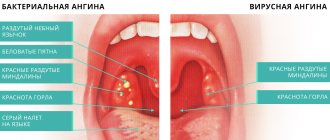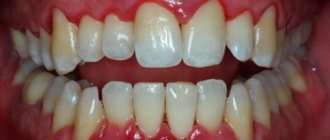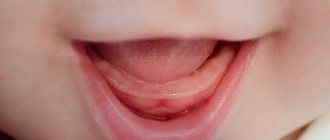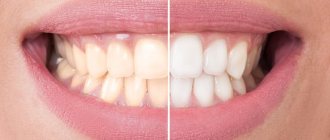Author of the article:
Soldatova Lyudmila Nikolaevna
Candidate of Medical Sciences, Professor of the Department of Clinical Dentistry of the St. Petersburg Medical and Social Institute, Chief Physician of the Alfa-Dent Dental Clinic, St. Petersburg
Teeth whitening is one of the most popular cosmetic procedures in dentistry. Every year more and more people, wanting to get a snow-white smile, resort to this service. Moreover, thanks to popularization and modern technologies, it has become available to almost everyone.
Whitening is a purely aesthetic procedure. It does not improve dental health and is contraindicated for pregnant women and people with sensitive tooth enamel. Although in these cases, dentists can choose the most suitable conditions. Therefore, the dream of an attractive bright smile can easily become a reality; it is only important to carefully listen to the advice of specialists and follow all their instructions.
The procedure itself is very simple - it can be carried out both in the office and at home. All methods are based on a single principle and differ only in details, although the intensity of the result, exposure time and probable harm depend on the latter.
If you have already decided to whiten your teeth, study all the nuances. Bright white color is not natural and achieving it causes some damage to the enamel. In addition, the procedure may have other side effects.
Let's talk about what to do if your teeth hurt after whitening.
Side effects
The appearance of pain during whitening is very individual and depends on many factors, including tooth sensitivity, the presence of damage to the enamel, and so on. In dentistry, there are a large number of effective methods to make the procedure itself painless. But what to do if the pain appears after. Like any medical intervention, bleaching has consequences due to the effects of instruments and drugs.
The most popular side effects from whitening are divided into three groups:
- toothache;
- gum irritation;
- increased sensitivity of teeth.
Increased sensitivity
It is this side effect that most often appears after teeth whitening. Unfortunately, despite its prevalence, doctors do not yet have a consensus on the causes of this phenomenon. Since sensitivity manifests itself differently each time, it is very difficult to predict the reaction of a particular patient, the severity and speed of treatment. Sensitivity can range from subtle discomfort to sharp, throbbing pain. Usually this effect goes away within a few seconds or minutes after the irritant stops acting on the enamel.
Tooth sensitivity may increase both during the procedure and after its completion.
If pain occurs during teeth whitening, then all work has to be stopped. The fact is that the basis of any lightening method is the effect on the enamel of active oxygen, which is released from special gels during the decomposition of hydrogen peroxide. It destroys the coloring pigment, penetrating deeply into the tooth tissue, which can cause irritation of the nerves. In this case, the only option is to stop using the drug.
Next, you need to take a break; if after that the problem does not appear, you can make another attempt by applying a less concentrated composition or shortening the period of exposure. This should take away the pain during whitening. If this does not happen, and discomfort appears again, you will have to stop the course and figure out the reasons. You may need to choose a different method or opt for a teeth-friendly professional cleaning. Of course, it will not make your teeth snow-white, but it will allow you to get their natural shade, lightening them by one or two tones.
If increased sensitivity appeared after the procedure during the recovery period, it is also necessary to understand and eliminate the reasons for its occurrence.
The most common are the following:
- negative effect from eating various foods - foods and drinks with high acidity can worsen the condition of teeth;
- manifestation of a reaction to external stimuli - heat, cold, physical contact;
- Increased sensitivity can be a sign of various diseases that are not directly related to teeth.
To eliminate the risk of tooth sensitivity as much as possible, dentists recommend using special toothpastes and rinses after whitening, as well as following a special diet. In the first days after the procedure, avoid the aggressive effects of smoking, cold, hot and acidic foods. Most likely, in three to four days the sensitivity will return to normal.
Toothache
In addition to increased sensitivity, which can be a completely normal phenomenon after the procedures, the patient may experience another unpleasant effect - a full-blown toothache. If you feel that your teeth really hurt and this cannot be attributed to temporary manifestations of their increased sensitivity, you should consult a specialist. Since the appearance of pain can serve as a signal of more serious problems, which are quite difficult to eliminate.
Teeth whitening has a strong impact on the condition of the oral cavity, so there are a number of contraindications in which the procedure should be abandoned.
To avoid any unpleasant surprises during or after whitening, you need to eliminate the following problems:
- caries;
- enamel diseases;
- defects on the tooth surface, chips and cracks;
- leaky seals
- gum disease and other soft tissue problems.
In most cases, toothache during whitening occurs due to the fact that the gel penetrates deep inside the tooth. This occurs due to the fact that the enamel contains cracks, chips, carious cavities and other defects. In addition, leaky seals can cause problems. Therefore, it is very important to identify these problems at the stage of preparation for cleaning, before any manipulations begin. It is necessary to undergo a full examination of the oral cavity, and then carry out all the necessary health procedures.
What happens when peroxide gets into the tooth structure? Active oxygen seeps through defects in the enamel, reaches the pulp and begins to affect the nerve endings, causing their irritation. At this point, the patient begins to experience toothache. And, accordingly, the longer the exposure time and the concentration of the active substance, the stronger the discomfort and the more dangerous the consequences. In the worst case, all this can lead to full-fledged inflammation - pulpitis. And this disease already requires serious treatment.
Therefore, if you notice chips or scratches on the enamel, or, worse, the tooth hurt even before whitening, be sure to contact a specialist.
If you want to avoid pain during and after teeth whitening, pay great attention to preparing for the procedure. Or use more gentle methods, for example, ASEPTA PLUS Gentle Whitening paste, which gently cleanses, returning teeth to their natural color.
Why do teeth become sensitive after whitening?
In the first days after the procedure, the enamel will be more sensitive; minor pain and reaction to temperature stimuli may occur. This is a completely normal phenomenon, since the teeth were exposed to aggressive external influences. However, there should not be acute pain - this situation indicates that the doctor chose the wrong dosage of the active substance.
Even the safest and gentlest whitening methods still have a negative effect on the enamel, destroying its mineral composition. Therefore, it is necessary to introduce healthy foods into the diet (see the list below), as well as use various preparations that will strengthen your teeth - in pharmacies you can purchase special pastes or compositions that are applied to the teeth for a few minutes.
Soreness after a session: what does it mean?
Quite often people have toothache after whitening. What to do in such an unpleasant situation? Hypersensitivity is a natural phenomenon that can be disturbing on the first, or maximum on the second day after a whitening session. The reason for this is the active influence of dental instruments and drugs used to improve color.
Special products (rinses and pastes) will help to significantly reduce increased sensitivity and associated discomfort. If the pain is not severe, then it is advised to simply be patient and not eat very cold or hot foods.
If the pain intensifies and does not go away within 2-3 days, you should visit the dentist. Perhaps its cause was caries, gum inflammation or other serious pathologies of the oral cavity, aggravated by the manipulation.
What diet should you follow after teeth whitening?
After bleaching, the enamel becomes more porous, and therefore there are certain restrictions in terms of nutrition and hygiene procedures. Therefore, after the lightening procedure, adhere to the “white diet”: exclude foods and drinks that contain coloring pigments and can lead to a change in the shade of the enamel. It is worth minimizing the amount of coffee, black tea, dark vegetables and fruits consumed.
To strengthen the enamel, introduce into your diet foods that contain large amounts of calcium and fluoride: milk, kefir, cottage cheese, fish, cheeses, eggs.
It is worth excluding factors that provoke unpleasant sensations, namely, too hard food, excessively hot and cold drinks. Follow the recommendation for an average of a week or longer, if necessary. It is also better to exclude sour and spicy foods from the diet: citrus fruits, sauces, ketchup, curry and other seasonings can increase tooth sensitivity.
What is better to forget: bad habits
Conducting a session forces a person to get rid of some addictions. Smoking does not benefit the body at all, and bleached teeth will turn black very quickly if you do not stop the addiction to cigarettes. The ingredients of tobacco smoke accumulate in the micropores of the enamel, which is exposed due to the procedure and becomes too vulnerable.
The habit of modern people to consume large quantities of caffeine also has a detrimental effect on the whiteness of treated teeth. It is recommended to direct your efforts to combat such “addiction”, because the aggressive pigments of caffeine-containing drinks instantly penetrate into the dental surface and neutralize the effect that was obtained through the brightening manipulation.
So, the amazing whitening results can be maintained for a long period. It is necessary to adhere to simple hygiene rules, follow a diet and overcome bad habits. A snow-white smile makes the face attractive, so your efforts will be completely justified!
Hygienic care rules
- Do not use a toothbrush with hard bristles - it will only increase the sensitivity that occurs immediately after the whitening procedure. It is better to give preference to a brush of medium hardness, since one that is too soft will not cope with removing plaque,
- Toothpaste should be free of abrasive substances that can damage the enamel. The best option is a paste to reduce hypersensitivity. It should be used for the first 2-3 weeks after whitening. Afterwards, it can be replaced with a paste that contains fluoride - this will be an excellent option for strengthening enamel and protecting against caries,
- After eating food (especially “coloring”), you should pay special attention to hygiene - use dental floss or a irrigator after each meal. And not only in the first days after whitening, but also in the subsequent ones - this recommendation should become a useful habit,
- Mouth rinses should not contain chlorhexidine, as it causes permanent staining of tooth enamel.
Even after whitening, you need to visit the dentist 1-2 times a year (but not earlier than six months later). Professional hygiene and removal of dental plaque will preserve the results and will be an excellent prevention of caries.
Women should avoid using lip gloss and bright lipstick for the first few days after whitening.
What recommendations should you follow?
You need to brush your teeth even more thoroughly than usual. Daily hygiene measures are carried out in the morning and evening, as well as after each meal. Duration of action – 3-4 minutes.
Use a soft-bristled brush, or even better, an electric one. It would be a good idea to get floss (or threads) and special brushes that tidy up the interdental spaces. Whitening paste or powder are indispensable assistants in maintaining the achieved result.
Have it professionally cleaned regularly. You should not ignore this service, because it allows you to:
- get rid of microbial plaque;
- touch those areas of the dental layers that are left unattended during home care;
- remove tartar;
- prevent periodontal diseases.
Hardware cleaning is recommended twice a year. After it, the doctor will certainly examine the oral cavity, which helps in the timely detection of all kinds of abnormalities.
Should I use home whitening products?
It is advisable to use homemade compositions to preserve the whitening results for a long time. But these should not be folk remedies, but professional ones, selected by your dentist. It is necessary to start using such compositions no earlier than 3 months after the professional procedure. It is better if the same system is used that was used in the clinic - for example, ZOOM or Amazing White - these brands provide formulations for use at home. But for this you will need to make individual mouth guards in which the active gel will be placed.
Whitening at home is especially effective for maintaining results after a professional procedure.
How to avoid this?
Firstly, you should not try to whiten your teeth at home using folk remedies that have not been previously approved by the dentist: soda, hydrogen peroxide, lemon juice, strawberry pulp, etc., of course, will give a visible result, but they can cause irreversible damage to the tooth enamel. The same applies to pharmacy kits for home teeth whitening - not all of them are really as harmless as the advertisements claim, and besides, the structure of each person’s teeth is individual, so for some, chemical home whitening may be effective, while others will not get any results, plus, then they will suffer from severe toothache.
Secondly, professional dentists warn that after whitening it is necessary to perform a set of special procedures aimed at building up and restoring tooth enamel. If a patient neglects the specialist’s recommendations, is negligent in oral hygiene and does not come to the doctor for an appointment, negative consequences will not be long in coming.
Thirdly, you need to contact only qualified, experienced doctors, in our clinic, where teeth whitening will be carried out taking into account all restrictions and contraindications - this is the surest guarantee that after the procedure the discomfort will be minimal, and toothache will not become a reason for frustration.
When it comes to a pathological process
- if the discomfort is prolonged and lasts longer than 5–10 days,
- the pain is acute and pulsating, appears regardless of external factors, and is not relieved by analgesics,
- Not only teeth, but also gums react to external influences.
In all of these cases, most likely, we are talking about a pathology that arose due to incorrectly selected whitening technology and lack of preparation for the procedure.
Important! Other signs of pathology: the presence of cracks and chips in the enamel, crumbling of teeth, swelling and redness of the gums, burns, itching in the mouth, ulcers and bumps on the mucous membrane, general deterioration in health, bad breath. If you leave such symptoms unattended, you can miss the purulent inflammatory process, contribute to the rapid destruction of teeth, the appearance of stomatitis and other dental problems.
Causes of pain and discomfort
Why does there be severe pain after teeth whitening? The reasons can be completely different:
- incorrectly chosen method of enamel lightening and incorrectly calculated concentration of the bleaching agent: if you consulted a professional doctor, then this situation is excluded,
- the use of folk recipes and home remedies: soda, salt, activated carbon, lemon - aggressive abrasives, which, if used ineptly or too often, can cause irritation of the mucous membrane and destruction of the enamel,
- lack of thorough sanitation: at the time of the whitening procedure, acute inflammatory processes, bacterial plaque, untreated caries and other dental pathologies are present in the oral cavity,
- the use of whitening systems and technologies despite contraindications: the presence of sensitive and thin enamel, pregnancy, lactation and age under 18 years, chips and cracks, the presence of braces, non-carious lesions (wedge-shaped defect, erosion, hypoplasia, fluorosis),
- eating too cold, hard, spicy and hot foods immediately after teeth whitening,
- the presence of leaky and old fillings,
- exposure of the necks and roots of teeth due to periodontal diseases and gum recession.
Can I use painkillers?
Usually there is no need for this, since the pain is not severe and short-lived, and quickly passes after the irritating factor is eliminated. If the unpleasant symptom is very strong and long-lasting, then you can use products from your home medicine cabinet, for example, Nurofen, Ketanov. Read about the most effective of them in a special review. But you need to understand that in this case the symptom indicates a pathology, and the listed drugs can be used for a maximum of 3-5 days in a row - during this time it is recommended to make an appointment with the dentist.
To relieve unpleasant symptoms in the gums, you can use topical creams and gels, for example, Kalgel, Cholisal, Metrogyl Denta. They have an anesthetic, disinfectant and anti-inflammatory effect.
Problems of increased sensitivity of teeth during the whitening procedure.
In June 2003, the same company released a new LumaCool unit.
(Fig. 11) Fig. 11 The LED technology used in LumaCool completely eliminates thermal radiation.
The LED technology used in it completely eliminates thermal radiation and thereby prevents the possibility of tooth sensitivity due to overheating of the dental pulp. In addition, a significant reduction in the duration of the whitening procedure reduces the exposure time of hydrogen peroxide to the teeth. LumaArch and LumaCool whitening methods provide from 16 to 24 minutes of active exposure of the teeth to the whitening gel and light for the full course of treatment. Recent studies have shown that when examining long-term results, whitening using the LumaArch unit causes the least amount of sensitivity compared to similar techniques.16 Finally, it should be noted that the likelihood of tooth sensitivity depends on the age of the patient. The dental cavity in children and adolescents is very large, which increases the likelihood of increased sensitivity. According to the latest research, teeth whitening is recommended from the age of 16.15 According to an analysis of the results of whitening of more than 3,000 patients conducted at our center, blond or red-haired teenage girls with blue eyes and white, thin skin are prone to increased tooth sensitivity when undergoing whitening in 6.7 times more than their dark-haired and brown-eyed peers.9
Thus, despite the fact that hypersensitivity is one of the most serious complications of teeth whitening, its incidence is insignificant and, with accurate diagnosis, selection of the optimal whitening method and its correct implementation, is about 0.5%.9 In addition, whitening does not causes no irreversible structural changes in the hard tissues of the teeth and the resulting sensitivity of the teeth goes away without a trace within 24 to 48 hours.
Literature.
1.Torneck CD, Titley KC, Smith DC, Adibfar A. The influence of time of hydrogen peroxide exposure on the adhesion of composite resin to bleached LumaArch bovine enamel. J endodont 1990;16:123-128. 2.Cvitko E, Denehy GE, Swift EJ Jr, Pires JA. Bond strength of composite resin to enamel bleached with carbamide peroxide. J Esthet Dent 1991;3(3):100-102. 3.Haywood VB, Heymann HO. Response of normal and tetracycline-stained teeth with pulp-size variation to nightguard vital bleaching. J Esthet Dent 1994;6(3):109-114. 4.Haywood VB, Houck V, Heymann HO. Nightguard vital bleaching: Effects of varying pH solutions on enamel surface texture and color change. Quintessence Int 1991;22:775-782. 5.Leonard RH, Bentley CD, Haywood VB. Salivary pH changes during 10% carbamide peroxide bleaching. Quintessence Int 1994;25:547-550. 6.McCracken MS, Haywood VB. Effects of 10% carbamide peroxide on the subsurface hardness of enamel. Quintessence Int 1995;26:21-24. 7.Haywood VB, Leonard RH, Nelson CF. Efficacy of foam liner in 10% carbamide peroxide bleaching technique. Quintessence Int 1993;24:663-666. 8.IARC Monograph. Evaluation of carcinogenesis risk of chemicals in humans. 1985;36:285-314. 9. Ronkin K. Modern methods of teeth whitening. Boston, 2002 10. Schmidt-Nielsen B. The solubility of tooth substance in relation to the composition of saliva. Acta Odont Scand 1946;7(2):1-13. 11.Hoppenbrouwers PMM, Driessens FCM, Borggreven JMPM. The vulnerability of unexposed human dental roots to demineralization. J Dent Res 1986;65:955-958. 12.Haywood VB, Leech T, Heymann HO, Crumpler D, Bruggers K. Nightguard vital bleaching: effects on enamel surface texture and diffusion. Quintessence Int 1990;21:801-806. 13. Quintessence Int 1992;23:471-488. 14. Haywood VB, Heymann HO. Nightguard vital bleaching: How safe is it? Quintessence Int 1991;22:515-523. 15. Tahmasebi C., Tash R., Cipolla A., Warner J., Margiotta A., Multiarch Vital Tooth Whitening Using a 15% Hydrogen Peroxide Gel Continuously Illuminated by a Gas Plasma Light Source. JCD 2000,16(1) 57-64. 16. Reality. Bleaching materials. Vol 27, 43-72, 2003.
Article courtesy of Boston Institute of Cosmetic Dentistry










